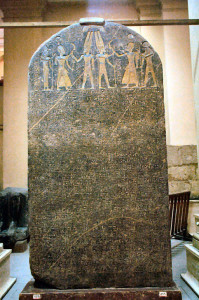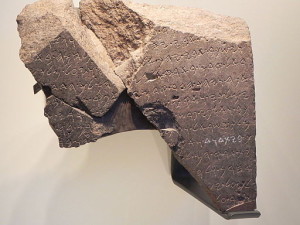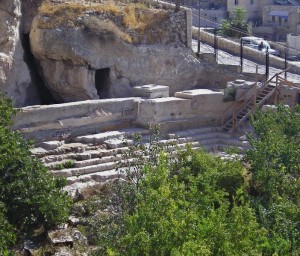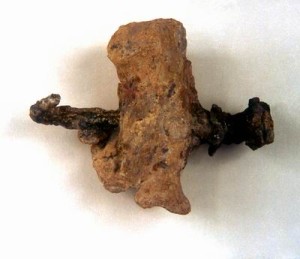 Probably the most basic, and most important, question one can ask about the Bible is “how do we know it’s true?” After all, other religious books also claim to be true. So why should we believe the Bible is any better or different from them? Additionally, a new breed of anti-biblical scholars and activist atheists consistently attack the Bible’s credibility with a seemingly endless list of charges. An excellent example of this type of work is the recent, and grossly inaccurate, Newsweek article from December 23, 2014, “The Bible: So Misunderstood It’s a Sin.”
Probably the most basic, and most important, question one can ask about the Bible is “how do we know it’s true?” After all, other religious books also claim to be true. So why should we believe the Bible is any better or different from them? Additionally, a new breed of anti-biblical scholars and activist atheists consistently attack the Bible’s credibility with a seemingly endless list of charges. An excellent example of this type of work is the recent, and grossly inaccurate, Newsweek article from December 23, 2014, “The Bible: So Misunderstood It’s a Sin.”
Since this question is of such fundamental importance and covers many topics, we will address it through a series of three articles. Through this series we will review the internal and external evidence for the Bible’s credibility, as well as address the claims of critics. In particular, since it is such a textbook example, numerous claims from the Newsweek article will be addressed. In the final analysis, we will demonstrate that the Bible is a very reliable work. It does, in fact, reveal God’s will to mankind and describes the only path to a permanent relationship with him.
First, we must define the standard of accuracy the Bible should be measured against. Ultimately, any work’s accuracy can be measured on a continuum from completely false to completely true. Opinions about the Bible range almost across this entire scale. Many Bible critics believe it is a combination of Hebrew and early Christian folklore that occasionally gets some historical information correct. Christians, on the other hand, believe the Bible is a divinely inspired work that reveals God’s will and plan for salvation.
“Divine Inspiration” and “Inerrancy”
Even genuine, Bible-believing Christians disagree at times on exactly what the phrase “divinely inspired” means. While every true Christian believes the Bible is trustworthy, they sometimes disagree on the extent of its “inerrancy.” Some claim that the Bible was written by men who were “inspired by God” but also included their own opinions and biases. Others believe the Bible was written as a spiritual guide, but is only inerrant in that realm and may contain errors in cosmology, geology, etc. Still others believe the Bible is entirely “God breathed” and is without any error. For purposes of this series, we will seek to establish this standard of full inerrancy.
Additional clarity is needed around the idea of full inerrancy. Full inerrancy does not mean that every word should be taken literally. Rather, it means that the message being communicated is without error. In other words, poetic or symbolic language and figures of speech are allowed. Inerrancy and divine inspiration also do not mean the authors could not express their own writing styles or address issues specific to their own cultures and times. Finally, full inerrancy applies only to the original texts, not all subsequent translations and versions.
There are several reasons why establishing full inerrancy is important. From a pragmatic standpoint, if one accepts that errors and personal opinions are in the Bible, we quickly end up with a form of “buffet” Christianity where people pick and choose only those parts they like and reject those they don’t. After all, how do we objectively determine which parts are in error and which ones are not? Ultimately we are left with little more than a “feel good” religion built on nice sounding platitudes, but no real accountability.
Finally, full inerrancy is important since biblical doctrines regarding the nature of mankind and God, the existence of sin, the need for a Savior, the person of Jesus, future judgment, etc. build and depend on each another. If one of the foundational doctrines is taken away, Christianity’s core is weakened. Granted, these arguments do not prove Biblical inerrancy, but they do speak to the importance of establishing a high standard.
Fortunately, there are many reasons to believe the Bible is reliable and inerrant. Textual criticism demonstrates beyond a reasonable doubt that we have highly accurate copies of the biblical books that correctly reflect the original writings. Historical and archeological findings have repeatedly corroborated the Bible’s claims. Internal evidences such as the Bible’s stunning and repeated prophetic accuracy and its clear consistency of message despite 1,500+ years and 40+ authors involved in its writing, imply a divine source. When combined with the fact that the attacks from biblical critics can be answered, we have a good case for full inerrancy.
External Evidence
Archaeology has corroborated the biblical account of history countless times. And despite more than 25,000 excavation sites from biblical times, nothing has been found that disproves a biblical statement. The archaeological support of the biblical narrative is so compelling that Dr. WF Albright of Johns Hopkins University stated “there can be no doubt that archaeology has confirmed the substantial historicity of the Old Testament tradition.” Further, Dr. Millar Burrows of Yale stated the “archaeological work has unquestionably strengthened confidence in the reliability of scriptural record.” An exhaustive survey of such archaeological finds would fill an entire book, but a brief list of some of the more interesting ones includes:
- Historians once believed the book of Daniel was wrong when it mentioned Belshazzar as the last king of Babylon, when records showed it was Nabonidus. However, archaeologists discovered a Babylonian chronicle that states Nabonidus removed himself from the throne and placed his son Belshazzar in charge.
- Thousands of Assyrian tablets verify each reference made to an Assyrian king in the Bible. Furthermore, in 1847, the palace of the Assyrian king Sennacherib was discovered. Reliefs within the palace show Sennacherib’s capture of the Israeli city of Lachish as described in 2 Kings.
- Sennacherib’s prism, also found in his palace, relates the subsequent siege of Jerusalem that occurred after Lachish. The Bible tells us in 2 Kings, 2 Chronicles, and Isaiah that Sennacherib did lay siege to Jerusalem but because of King Hezekiah’s trust in God, the Assyrians did not capture the city. The prism is consistent with this account as it describes Sennacherib’s siege but makes no mention of an actual conquest. It is very odd that formal records, often meant to propagandize the world’s most powerful military at the time, indirectly admit they did not conquer Jerusalem.
- Interestingly, archeologists have also discovered the tunnel Hezekiah dug to supply water to Jerusalem during Sennacherib’s siege. The tunnel is briefly mentioned in 2 Kings 20:20. The tunnel itself was found in 1838 and is over 1,700 feet long! It has been dated to ~700 BC, consistent with the biblical timeline, and was dug 131 feet underground, for approximately 1/3 of a mile, with no modern tools. Truly an amazing feat!
-
The Merneptah Stela is a stone slab discovered in Thebes, Egypt in 1896. It is a poetic eulogy to Pharaoh Merneptah, who ruled from 1212-1202 BC. The stela mentions Israel by name when describing one of the pharaoh’s military campaigns. This mention is important for several reasons. First, it demonstrates that Israel was a significant and known entity during the pharaoh’s reign. Secondly, it proves the error in a popular theory among secular biblical scholars that Israel merely emerged from the indigenous Canaanite people in the mid-1100’s BC, contrary to the biblical record. If Israel was an established and known political entity in circa 1210 BC, the “emergence theory” is wrong and the biblical record stands.
- Excavations of what are believed to be the biblical cities of Sodom and Gomorrah show extensive evidence of catastrophic destruction from extreme heat and possible seismic activity. This exactly mirrors the devastation described in the Bible as having resulted from God’s judgment on the cities.
- For many years, historians thought King David was merely an invention of Israeli mythology that existed only in the Bible. However, he was verified as real with the discovery of an 8th century BC inscription from an Aramaean king that refers to the “house of David.”
- Excavations of the ancient city of Jericho provide evidence of a sudden and complete destruction that is consistent with the book of Joshua. Archeologists also conclude that the heavily fortified walls fell outward. This is exactly opposite of what would normally happen from a biblical era siege, but is entirely consistent with the Bible’s narrative of a miraculous collapse of the walls to let the Israelites attack. The first modern era excavation of Jericho by John Garstag dated this destruction to approximately 1,400 BC, mirroring the biblical timeline. His dating was later questioned by Kathleen Kenyon, who claimed it occurred in approximately 1,550 BC which was too early to be from the Israelites. However, her dating was based primarily on the lack of a particular type of pottery she expected to find from the later period. Some subsequent archeologists have questioned her conclusion since her excavation focused on what appeared to be one of the poorer sections of town where such pottery was less likely. So the earlier dating is a conjecture based on an assumption, leaving the biblical account intact.
- The Hittites were a group of people once thought to have existed only in the Bible, until their capital and records were found in Turkey.
- The Assyrian King Sargon, as mentioned in Isaiah 20, was thought to be a biblical error since his name was not found in other known records. Then his palace was discovered in Iraq and the story of his capturing the Israeli city of Ashdod, as described in Isaiah, was recorded on the palace walls!
- Babylonian cuneiform tablets support Nebuchadnezzar’s siege and defeat of Israel’s king Jehoiachin in the 6th century BC as described in 2 Kings.
- A Persian clay cylinder dating to the 6th century BC describes King Cyrus’ victory over Babylon in 536 BC, fulfilling Isaiah’s prophecy from over 100 years earlier. It also confirms that Cyrus allowed freedom of worship and let conquered peoples return to their lands and rebuild temples, consistent with claims made in Isaiah, Daniel, and Ezra.
-
In 2004, the Pool of Siloam was discovered in Jerusalem. This pool, which is where the Gospel of John says Jesus cured a blind man, was once thought to be created by John as a symbolic literary device. Its discovery lends historical credibility to John. An even more recent discovery in Jerusalem, this one of the palace where Jesus’ trial likely took place, also lends historical credibility to John’s gospel.
- Critical scholars used to doubt Jesus would have been crucified in the first century in the manner described in the gospels. However, a first century ossuary was discovered in northern Jerusalem that contained the bones of a crucified man named Yehohanan, proving that crucifixion was done in this manner at that time and that bodies of crucified people could be buried.
-
Archeologists have verified at least 50 leaders mentioned throughout the Bible. Examples include many of Israel’s and Judah’s kings such as David, Hezekiah, Uzziah, Ahaz, Manasseh, Jehoiachin, Ahab, Omri, Joash, Jeroboam II, Menahem, Pekah, and Hoshea. Foreign leaders including Sennacherib, Tiglath-pileser III, Shalmaneser V, Sargon II, Esarhaddon, Nebuchadnezzar, Belshazzar, Cyrus the Great, Darius I and II, Xerxes, and Artaxerxes II, among others have also been verified.
- Luke, in particular, has been validated as an able historian. Archeological finds have verified Luke’s correct recording of 32 countries, 54 cities, 9 islands, and 13 rulers or political leaders.
These are simply a sample of the many archaeological finds that verify biblical histories. Suffice it to say that archaeology has consistently shown the biblical texts to be accurate, even when historians originally felt they were in error.
In Part II, we’ll explore some of the internal evidence of the Bible’s reliability.




